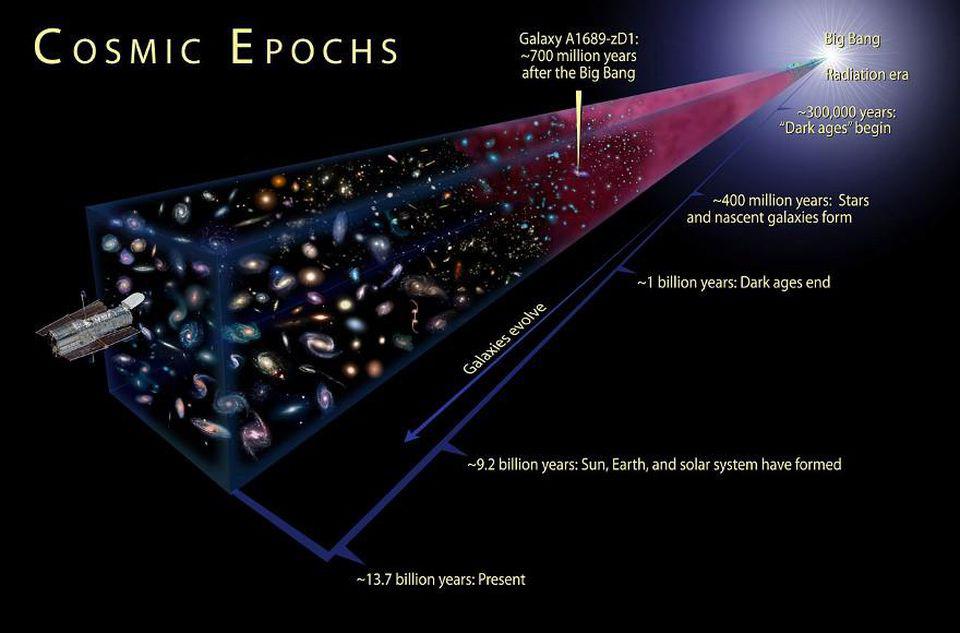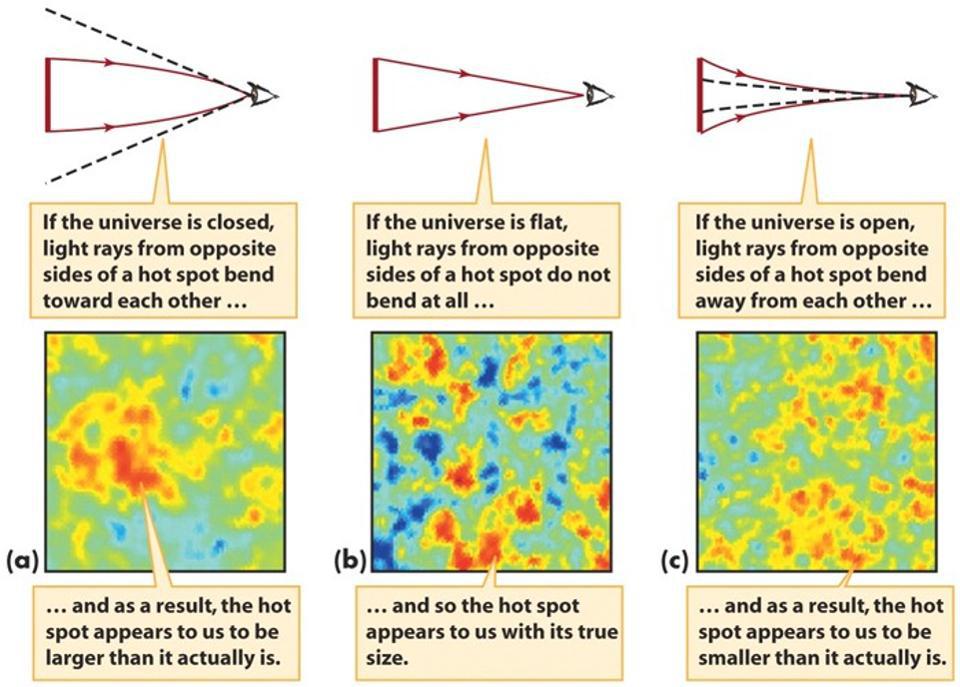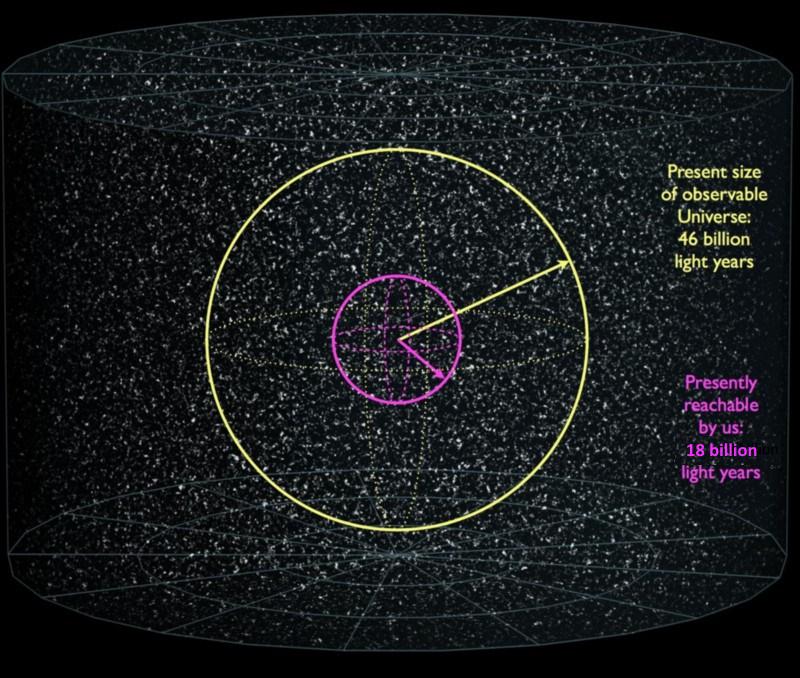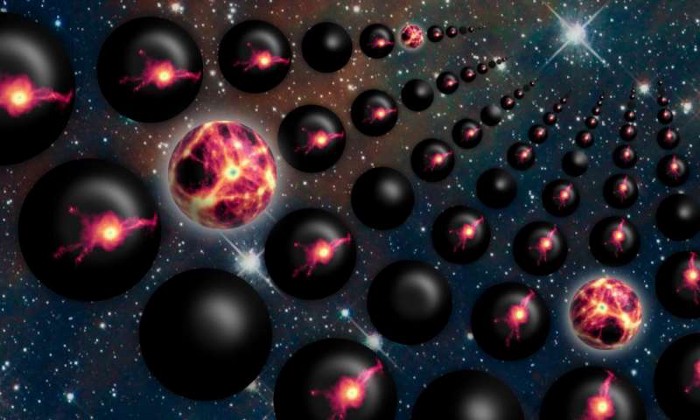13.8 billion years ago, what we know as our Universe began with the hot Big Bang. The Universe was filled with matter, antimatter, radiation, and existed in an ultra-hot, ultra-dense, but expanding-and-cooling state. By today, the volume containing our observable Universe has expanded to be 46 billion light years in radius, with the light that’s first arriving at our eyes today corresponding to the limit of what we can measure.
Although that’s a huge distance, it’s not infinitely large; it’s merely the limits of what we can observe. What lies beyond that? What about the unobservable Universe? Is there any way to use what we know and measure about the Universe we inhabit to answer the question of whether it’s finite or infinite; about whether what we know of as “the Universe” goes on forever, or whether there’s some limit to what’s out there? Let’s look at the full suite of what we know today, right up to the limits of what our measurements tell us, and see what we can learn from it.

As we look to greater distances, we also wind up looking back in time. The nearest galaxy, some 2.5 million light years away, appears to us as it was 2.5 million years ago, because the light requires that much time to journey to our eyes from when it was emitted. More distant galaxies appear as they were tens of millions, hundreds of millions or even billions of years ago. As we look ever farther away in space, the light we see from the Universe comes from its progressively younger days. Therefore, as we look back in terms of distance, we can also measure how the Universe evolved over its history.
The Universe is cold and clumpy today, but it’s also expanding and gravitating. When we look to greater and greater distances, we find that the Universe was less cold, less clumpy, and more uniform. With less time having passed for gravitation to form large, complicated structures, the Universe had less massive clumps of matter early on. Similarly, the early, distant Universe was also hotter. The expanding Universe causes all the light that travels through the Universe to stretch in wavelength. As the wavelength stretches, it loses energy, and becomes cooler. This means the Universe was hotter in the distant past, a fact we’ve confirmed through observations of distant features in the Universe.

We can measure the temperature of the Universe as it is today, 13.8 billion years after the Big Bang, by looking at the leftover radiation from that hot, dense, early state. Today, this shows up in the microwave portion of the spectrum and is known as the Cosmic Microwave Background. Coming in with a blackbody spectrum and a temperature of 2.725 K, it’s easy to confirm that these observations match, with an incredible precision, the predictions that arise from the Big Bang model of our Universe.
Moreover, we know how this radiation evolves in energy as the Universe expands. A photon’s energy is directly proportional to the inverse of its wavelength. When the Universe was half its size, the photons from the Big Bang had double the energy, while when the Universe was 10% of its current size, those photons had ten times the energy. If we’re willing to go back to when the Universe was just 0.092% its present size, we’ll find a Universe that’s 1089 times hotter than it is today: around 3000 K. At these temperatures, the Universe is hot enough to ionize all the atoms in it. Instead of solid, liquid, or gas, all the matter in the entire Universe was in the form of an ionized plasma.

One of the remarkable properties about the Universe, at this early stage, was how almost perfectly uniform it was. Yes, some regions within it are more or less dense than average, but the amounts that the densest (corresponding to the coldest observed temperatures) or least dense (i.e., hottest) regions depart from the average is tiny: about 1-part-in-30,000. That’s enough to grow into the stars, galaxies, galaxy clusters, and cosmic voids we see today. Seeing the Universe as it was back then, as well as how it is today, allows us to understand how it grew from that early state into the one we inhabit today.
The way we arrive at the size of the visible Universe today is through understanding three things in tandem:
- how quickly the Universe is expanding today, something we can measure via a number of methods,
- how hot the Universe is today, which we know from looking at the radiation of the Cosmic Microwave Background,
- and what the Universe is made out of, including matter, radiation, neutrinos, antimatter, dark matter, dark energy, and more.
By taking the Universe we have today, we can extrapolate back to the earliest stages of the hot Big Bang, and arrive at a figure for both the age and the size of the Universe together.

From the full suite of observations available, including the cosmic microwave background but also including supernova data, large-scale structure surveys, and baryon acoustic oscillations, among others, we get our Universe. 13.8 billion years after the Big Bang, it’s now 46.1 billion light years in radius. That’s the limit of what’s observable. Any farther than that, and even something moving at the speed of light since the moment of the hot Big Bang will not have had sufficient time to reach us. As time goes on, the age and the size of the Universe will increase, but there will always be a limit to what we can observe.
So what can we say about the part of the Universe that’s beyond the limits of our observations? We can only make inferences based on the laws of physics as we know them, and the things we can measure within our observable Universe. If space were positively curved, like we lived on the surface of a 4D sphere, distant light rays would converge. If space were negatively curved, like the surface of a 4D saddle, distant light rays would diverge. Instead, distant light rays move in their original direction, with the fluctuations we have indicating perfect flatness.

Our best measurements indicate that the Universe is spatially flat on the largest scales: it’s neither positively nor negatively curved, to a precision of 0.25%, or about 1-part-in-400. Because we live in three dimensions, 400 times the radius means (400)3 times the volume, or more than 64 million times as much space. If we assume that our current laws of physics are correct, we can set limits on how large, at least, the Universe must be before it curves back on itself.
But, big as that is, it still isn’t infinite. A lower bound of the Universe being at least 18 trillion light-years in all directions is tremendous, but it’s still finite. Assuming that the Universe contains no topological weirdness, like curving back on itself while still being spatially flat (like having a geometry akin to a hypertorus), observations of the cosmic microwave background and the large-scale structure tell us that the unobservable part of the Universe must be at least 37 trillion light-years in diameter.

However, there are good theoretical reasons to believe that our entire Universe, whether finite or infinite, is even larger than that. The hot Big Bang might mark the beginning of the observable Universe as we know it, but it doesn’t mark the birth of space and time itself. Before the Big Bang, the Universe underwent a period of cosmic inflation. Instead of being filled with matter and radiation, and instead of being hot, the Universe was:
- filled with energy inherent to space itself,
- expanding at a constant, exponential rate,
- and creating new space so quickly that the smallest physical length scale, the Planck length, would be stretched to the size of the presently observable Universe every 10-32 seconds.
It’s true that in our region of the Universe, inflation came to an end. But there are three questions we don’t know the answer to that have a tremendous influence on how big the Universe truly is, and whether it’s infinite or not.

1.) How big was the region of the Universe, post-inflation, that created our hot Big Bang? Looking at our Universe today, at how uniform the Big Bang’s leftover glow is, at how flat the Universe is, at the fluctuations stretched across the Universe on all scales, etc., there’s quite a bit we can learn. We can learn the upper limit to the energy scale at which inflation occurred; we can learn how much the Universe must have inflated; we can learn a lower limit for how long inflation must have gone on.
But the pocket of the inflating Universe that gave rise to us could be much, much bigger than that lower limit! It could be hundreds, or millions, or googols of times larger than what we can observe… or even truly infinite. But without being able to observe more of the Universe than we can presently access, we don’t have enough information to decide.

2.) Is the idea of “eternal inflation,” where the Universe inflates eternally into the future in at least some regions, correct? If you consider that inflation must be a quantum field, then at any given point during that phase of exponential expansion, there’s a probability that inflation will end, resulting in a Big Bang, and a probability that inflation will continue, creating more and more space. These are calculations we know how to do (given certain assumptions), and they lead to an inevitable conclusion: if you want enough inflation to occur to produce the Universe we see, then inflation will always create more space that continues to inflate compared to the regions that end and produce Big Bangs.
While our observable Universe may have come about from inflation ending in our region of space some 13.8 billion years ago, there are regions where inflation continues — creating more and more space and giving rise to more Big Bangs — continuing to the present day. This idea is known as eternal inflation, and is generally accepted by the theoretical physics community. How big, then, is the entire unobservable Universe by now?

3.) And, finally, how long did inflation go on prior to its end and the resultant hot Big Bang? We can only see the observable Universe created by inflation’s end and our hot Big Bang. We know that inflation must have occurred for at least some ~10-32 seconds or so, but it likely went on for longer. But how much longer? For seconds? Years? Billions of years? Or even an arbitrary, infinite amount of time? Has the Universe always been inflating? Did inflation have a beginning? Did it arise from a previous state that was around eternally? Or, perhaps, did all of space and time emerge from nothingness a finite amount of time ago? These are all possibilities, and yet the answer is untestable and elusive at present.
From our best observations, we know that the Universe is an awful lot bigger than the part we can observe. Beyond what we can see, we strongly suspect that there’s plenty more Universe out there just like ours, with the same laws of physics, the same types of physical, cosmic structures, and the same chances at complex life. But as inconceivably large as that entire Universe — or Multiverse, if you prefer — may be, it might not be infinite. In fact, unless inflation went on for a truly infinite amount of time, or the Universe was born infinitely large, the Universe ought to be finite in extent.

The biggest problem of all, though? It’s that we don’t have enough information to definitively answer the question. We only know how to access the information available inside our observable Universe: those 46 billion light years in all directions. The answer to the biggest of all questions, of whether the Universe is finite or infinite, might be encoded in the Universe itself, but we can’t access enough of it to know. Until we either figure it out, or come up with a clever scheme to expand what we know physics is capable of, all we’ll have are the possibilities.
This article was reprinted with permission of Big Think, where it was originally published.




